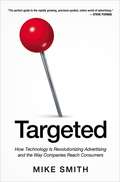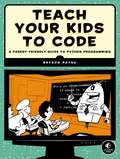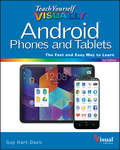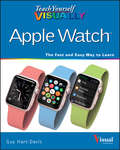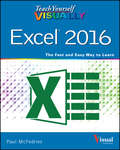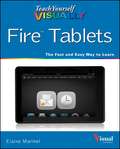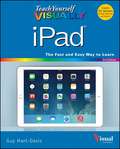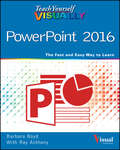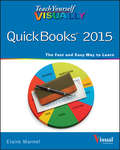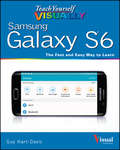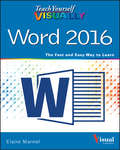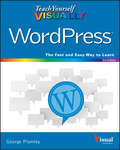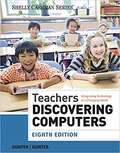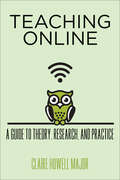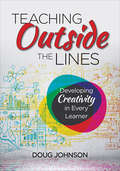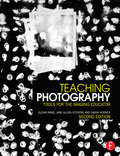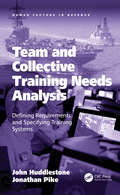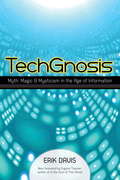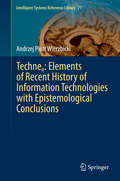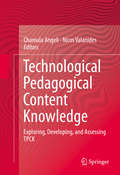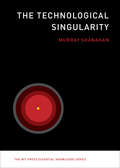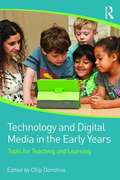- Table View
- List View
Targeted: How Technology Is Revolutionizing Advertising and the Way Companies Reach Consumers
by Mike SmithFar from the catchy television spots and sleek magazine spreads are the comparatively modest ads that pop up on websites and in Internet searches. But don't be fooled--online advertising is exploding. Growing at a compound annual rate near 20%, it is now the second-largest advertising channel in the United States. Part history, part guidebook, part prediction for the future, Targeted tells the story of the companies, individuals, and innovations driving this revolution. It takes readers behind the scenes--examining the growth of digital advertising, its enormous potential, and the technologies that are changing the game forever. Leading the way is real-time bidding, which offers advertisers unprecedented precision in targeting ads and measuring their effectiveness. From keyword micro-markets and ad serving systems to aggregated virtual audiences and new business models, Targeted is sweeping in scope and stripped of technical complexity. It is an essential resource for anyone interested in finding and connecting with customers in the vast and shifting Internet universe.
Teach Your Kids to Code
by Bryson PayneTeach Your Kids to Code is a parent's and teacher's guide to teaching kids basic programming and problem solving using Python, the powerful language used in college courses and by tech companies like Google and IBM.Step-by-step explanations will have kids learning computational thinking right away, while visual and game-oriented examples hold their attention. Friendly introductions to fundamental programming concepts such as variables, loops, and functions will help even the youngest programmers build the skills they need to make their own cool games and applications.Whether you've been coding for years or have never programmed anything at all, Teach Your Kids to Code will help you show your young programmer how to:–Explore geometry by drawing colorful shapes with Turtle graphics–Write programs to encode and decode messages, play Rock-Paper-Scissors, and calculate how tall someone is in Ping-Pong balls–Create fun, playable games like War, Yahtzee, and Pong–Add interactivity, animation, and sound to their appsTeach Your Kids to Code is the perfect companion to any introductory programming class or after-school meet-up, or simply your educational efforts at home. Spend some fun, productive afternoons at the computer with your kids—you can all learn something!
Teach Yourself VISUALLY Android Phones and Tablets: The Fast And Easy Way To Learn (Teach Yourself VISUALLY (Tech))
by Guy Hart-DavisExperience all your Android device has to offer! Teach Yourself VISUALLY Android Phones and Tablets, 2nd Edition is the perfect resource if you are a visual learner who wants to master the ins and outs of the Android operating system. With step-by-step instructions driven by targeted, easy-to-understand graphics, this informative book shines a light on the features, functions, and quirks of the Android OS—and shows you how to use them. With the guidance provided by this easy to follow resource, you will quickly access, download, and enjoy books, apps, music, and video content, as well as photos, emails, and other forms of media, right from your phone or tablet! This book is perfect for Android users at beginner to intermediate levels. The Android operating system is graphics intensive, which is why a visual guide is the best way to navigate your Android device. Now that the Android OS is available on both phones and tablets, you can maximize the productivity and convenience of your devices by mastering the features, functions, and quirks of this operating system. Explore the latest Android features and functions Peruse full-color illustrations that walk you, step-by-step, through instructions for using the Android operating system Discover how to access, download, and enjoy multimedia content Sync your Android devices to maximize their capabilities Teach Yourself VISUALLY Android Phones and Tablets, 2nd Edition is the top resource for visual learners wanting to further explore the capabilities of Android devices.
Teach Yourself VISUALLY Apple Watch
by Guy Hart-DavisWatch. Learn the features visually with 400 full-color screen shotsMaster the basic Apple Watch functions and customize your settingsGet optimal performance from your smartwatch with expert tipsFind the best apps and services to fit your personal needsThe Apple Watch's graphics-intensive touch interface is perfect for visual learners, and this guide mirrors that feature with a highly visual approach to using both the OS and the device itself. With full coverage, plenty of screen shots, and expert tips and tricks, Teach Yourself VISUALLY Apple Watch is the companion you cannot be without.
Teach Yourself VISUALLY Excel 2016 (Teach Yourself VISUALLY (Tech))
by Paul McFedriesSee your way to Excel spreadsheet stardom with this visual guide If you're always hearing about the cool things Excel can do, here's your chance to see how to do them!Teach Yourself Visually Excel offers you a straightforward visual approach to working with the newest version of the world's leading spreadsheet program. Packed with visually rich tutorials and step-by-step instructions that will help you take your Excel skills to new heights, this friendly and approachable guide will have you creating, editing, and manipulating Excel spreadsheets in no time! Excel can seem daunting, but with Teach Yourself Visually Excel, you'll quickly and painlessly learn how to perform dozens of tasks, including creating spreadsheets and charts, filtering and sorting data, working with PivotTables, and so much more. Covering the latest additions and changes to the newest version of Excel, a series of easy-to-follow, full-color tutorials helps you to excel at working with Excel! Tutorials and step-by-step screenshots make lessons easy to follow and understand Helps you grasp the basic functions of Excel—and beyond Walks you through Excel s new features Clearly demonstrates how to organize, present, analyze, and chart data with Excel Whether you've never used Excel or just need to brush up on its new features, Teach Yourself Visually Excel will be the dog-eared resource you'll turn to again and again.
Teach Yourself VISUALLY Fire Tablets
by Elaine MarmelExpert visual guidance to getting the most out of your Fire tabletTeach Yourself VISUALLY Fire Tablets is the comprehensive guide to getting the most out of your new Fire tablet. Learn to find and read new bestsellers through the Kindle app, browse the app store to find top games, surf the web, send e-mail, shop online, and much more! With expert guidance laid out in a highly visual style, this book is perfect for those new to the Fire tablet, providing all the information you need to get the most out of your device. Abundant screenshots of the Fire tablet graphically rich, touch-based Android interface provide easy-to-follow guidance.The Fire tablet's high capability and low price have made it a bestselling Android tablet. Beyond making Amazon transactions a seamless process, the device provides all the services tablet users have come to expect. This Teach Yourself VISUALLY guide explores the many features and content options available on the Fire tablet, allowing you to take full advantage of all the device has to offer.Find out how to use your Fire tablet to download books, music, and video contentAccess apps and send e-mails with the tablet that does it allSync your Fire tablet with other devices and servicesLearn to use the easy, intuitive multi-touch displayThe Fire tablet has become one of the most popular entertainment and media devices on the market. Teach Yourself VISUALLY Fire Tablets is the comprehensive guide that shows you what the Fire tablet can do for you.
Teach Yourself VISUALLY iPad
by Guy Hart-DavisLearn the basics and beyond with this visual guide to the iPad, iPad Air, and iPad miniTeach Yourself VISUALLY iPad, 3rd Edition is a clear, concise, image-rich guide to getting the most out of your iPad or iPad mini. Designed to quickly get you the answers you need, this book cuts to the chase by skipping the long-winded explanations and breaks each task down into bite-sized pieces. You'll find step-by-step instruction for everything from the initial setup to working with key features, plus troubleshooting advice that can help you avoid a trip to the Apple Genius Bar. Helpful sidebars highlight tips and tricks that get things done faster, and plenty of full-color screenshots help you visualize the lesson at hand. New users will learn how to take advantage of all the iPad has to offer, and experienced users may discover techniques to streamline everyday tasks.Now that you have this coveted device in your hands, you want to use every feature and maximize every capability. Teach Yourself VISUALLY iPad helps you do just that, walking you through each step in the iPad experience. You'll learn to:Get the most from any model of the iPad, iPad Air, or iPad miniCustomize your iPad and connect with WiFi and BluetoothAccess music, videos, games, photos, books, and appsSet up your e-mail, browse the Web, and manage social mediaTroubleshoot and fix minor issues that ariseTooling around on your own is fun, but you'll miss some of the lesser-known features that help make the iPad the superior device it is. This guide provides a visual tour, complete with expert instruction. If you're looking to get more out of your iPad, Teach Yourself VISUALLY iPad, 3rd Edition is essential reading.
Teach Yourself VISUALLY PowerPoint 2016 (Teach Yourself VISUALLY (Tech))
by Barbara BoydThe uncomplicated PowerPoint guide designed specifically for visual learners Are you a visual learner who wants to spend more time working on your presentations than trying to figure out how to create them? Teach Yourself Visually PowerPoint offers you an effortless approach to creating winning presentations with the latest version of PowerPoint. This accessible resource features visually rich tutorials and step-by-step instructions that will help you understand all of PowerPoint's capabilities—from the most basic to the most advanced. With Teach Yourself Visually PowerPoint, you'll learn how to create slides, dress them up using templates and graphics, add sound and animation, present in a business or Internet setting, and so much more. Covering the latest additions and changes in the new version of PowerPoint, a series of easy-to-follow, full-color tutorials helps you to quickly get up and running using PowerPoint like a pro! Highly visual tutorials and step-by-step screenshots make lessons easy to follow and understand Helps you learn the basic functions of PowerPoint—and beyond Walks you through PowerPoint's latest features Demonstrates how to create memorable and captivating presentations using PowerPoint Do you prefer instructions that show you how to do something—and skip the long-winded explanations? If so, Teach Yourself Visually PowerPoint is for you.
Teach Yourself VISUALLY QuickBooks 2015
by Elaine MarmelThe visual way to master QuickBooks XIf you learn better by seeing rather than wading through confusing text, then this visual guide is for you! Teach Yourself Visually QuickBooks X gives you hundreds of succinctly captioned, step-by-step screenshots that reveal how to master QuickBooks X and get your business finances in working order. QuickBooks X is the world's most popular accounting software, but that doesn't mean it's easy to figure out on your own. In this great guide, you'll find tons of visual references that make it easy to navigate QuickBooks X. Learn how to store and process company names, addresses, and account information, track accounts payable, compile and integrate data, produce reports for tracking and analyzing financial data, and so much more--all with visual references that won't make you pull your hair out!Find out how to choose a company identity and set up your sales taxCut through the jargon and see how to edit paycheck information and track employees' time recordsCreate invoices and estimates with QuickBooks XFollow along with easy-to-decipher screenshots that make it clear how to pay bills online and print financial reportsIf you're a visual learner interested in getting your business finances in order, this see-as-you-go guide makes it easier to master QuickBooks X without the headache of trying to figure out hard-to-read text.
Teach Yourself VISUALLY Salesforce.com (Teach Yourself VISUALLY (Tech))
by Justin Davis Kristine CuringtonThe highly visual, step-by-step guide to getting the most out of Salesforce.com Teach Yourself VISUALLY Salesforce.com, 2nd Edition is your ideal guide to getting up to speed on the world's number-one on-demand customer relationship management (CRM) system. With full color screenshots and step-by-step instructions, this highly visual manual shows you everything you need to know to get the most out of Salesforce.com. You'll be walked through each step of the entire process, from choosing the right edition and customizing your service to capturing leads, inputting contacts, tracking correspondence, reviewing reports, and more. This updated edition covers the newest features and tools that make your business run more smoothly, so you can get up and running quickly. This book is your ultimate guide to optimizing Salesforce.com capabilities, helping you leverage your data into added value for your business. Choose the right Salesforce.com edition to suit your needs Master the latest and most helpful features Personalize your system for a tailor-made CRM solution Manage accounts, develop contacts, track inventory, and more
Teach Yourself VISUALLY Samsung Galaxy S6
by Guy Hart-DavisYour visual guide to unlocking the full potential of the Samsung Galaxy Teach Yourself VISUALLY Samsung Galaxy is your step-by-step, visual guide to everything your new phone has to offer. With expert guidance from veteran technology author Guy Hart-Davis, it offers clear, concise instructions and pages of full-color screenshots that make it easy to learn how to fully utilize the Galaxy's latest features and capabilities from initial set-up to staying in touch, organizing your life, playing games, watching media, and more! Configure and get your phone set up just the way you want it Text, e-mail, use social networking, and take pictures easily Get access to the Internet, maps, and navigation in a snap Download apps and sync your Galaxy S6 with other devices Your new Samsung Galaxy can streamline your life and keep you organized — all with the touch of a finger. Make the most of the experience with Teach Yourself VISUALLY Samsung Galaxy!
Teach Yourself VISUALLY Word 2016 (Teach Yourself VISUALLY (Tech))
by Elaine MarmelVisually learn the latest version of Word Are you a visual learner who prefers to see how Word works instead of hear a long-winded explanation?Teach Yourself Visually Word offers you a straightforward 'show me, don't tell me' approach to working with the newest version of the top-selling application in the Microsoft Office suite. Packed with visually rich tutorials and step-by-step instructions that will help you come to grips with all of Word's capabilities, this accessible resource will quickly and easily get you up and running on using the world's most widely used word processing program. With Teach Yourself Visually Word, you'll learn how to perform dozens of tasks, including how to set up and format documents and text in Word; work with diagrams, charts, and pictures; use Mail Merge; post documents online; and much more. Covering the newest additions and changes to the latest version of Word, a series of easy-to-follow, full-color tutorials helps you to quickly get up and running with Word like a warrior! Tutorials and step-by-step screenshots make lessons easy to follow and understand Helps you grasp the basic functions of Word—and beyond Walks you through Word's new features Demonstrates how to set up, format, and edit Word documents If you're new to the world of Word and want a highly visual roadmap to help you put it to use for you, Teach Yourself Visually Word has you covered.
Teach Yourself VISUALLY WordPress
by George PlumleyClear the "blog fog" with this complete visual guide to the WordPress platform Teach Yourself VISUALLY WordPress, 3rd Edition introduces you to the exciting possibilities of one of the world's most popular blogging platforms, and shows you how to build your blog from idea to execution. This edition has been updated to reflect the changes and new features of WordPress, and includes coverage of mobile blogging solutions that allow you to post on the go. Richly illustrated with screenshots and examples from the author's own WordPress blogs, this highly visual guide walks you through the setup and creation process step by step, and offers expert tips and tricks every step of the way. From installing WordPress and choosing a theme to custom site editing and self-hosting, this book provides the answers you need and helps you get organized and published quickly.This is your essential guide to getting the most out of WordPress, from basic setup to advanced mobile features. Customize your site with plug-ins, themes, and personalized editing Blog whenever, wherever, with mobile blogging solutions Buy your domain, choose a hosting service, and set up the admin stuff Learn the best practices that result in engaging, dynamic websites Whether you're promoting a business, building a personal brand, or just have something to say, this is your no-nonsense guide to building your blog.
Teachers Discovering Computers: Integrating Technology in a Changing World
by Glenda A. Gunter Randolph E. GunterTEACHERS DISCOVERING COMPUTERS: INTEGRATING TECHNOLOGY IN A CHANGING WORLD, EIGHTH EDITION introduces future educators to technology and digital media in order to help them successfully teach the current generation of digital students.
Teaching and Digital Technologies
by Michael Henderson Geoff RomeoTeaching and Digital Technologies: Big Issues and Critical Questions helps both pre-service and in-service teachers to critically question and evaluate the reasons for using digital technology in the classroom. Unlike other resources that show how to use specific technologies – and quickly become outdated, this text empowers the reader to understand why they should (or should not) use digital technologies, when it is appropriate (or not), and the implications arising from these decisions. The text directly engages with policy, the Australian Curriculum, pedagogy, learning and wider issues of equity, access, generational stereotypes and professional learning. The contributors to the book are notable figures from across a broad range of Australian universities, giving the text a unique relevance to Australian education while retaining its universal appeal. Teaching and Digital Technologies is an essential contemporary resource for early childhood, primary and secondary pre-service and in-service teachers in both local and international education environments.
Teaching Online: A Guide to Theory, Research, and Practice (Tech.edu: A Hopkins Series on Education and Technology)
by Claire Howell MajorDemystifies online teaching for both enthusiastic and wary educators and helps faculty who teach online do their best work as digital instructors.It is difficult to imagine a college class today that does not include some online component—whether a simple posting of a syllabus to course management software, the use of social media for communication, or a full-blown course offering through a MOOC platform. In Teaching Online, Claire Howell Major describes for college faculty the changes that accompany use of such technologies and offers real-world strategies for surmounting digital teaching challenges.Teaching with these evolving media requires instructors to alter the ways in which they conceive of and do their work, according to Major. They must frequently update their knowledge of learning, teaching, and media, and they need to develop new forms of instruction, revise and reconceptualize classroom materials, and refresh their communication patterns. Faculty teaching online must also reconsider the student experience and determine what changes for students ultimately mean for their own work and for their institutions. Teaching Online presents instructors with a thoughtful synthesis of educational theory, research, and practice as well as a review of strategies for managing the instructional changes involved in teaching online. In addition, this book presents examples of best practices from successful online instructors as well as cutting-edge ideas from leading scholars and educational technologists. Faculty members, researchers, instructional designers, students, administrators, and policy makers who engage with online learning will find this book an invaluable resource.
Teaching Outside the Lines: Developing Creativity in Every Learner
by Douglas A. JohnsonMake Creativity The Center Of The Curriculum! In our fast-changing world, the ability to think independently and innovatively is no longer a “nice extra”—it’s a survival skill. This book delivers surefire strategies for equipping learners across all grades and subjects with the motivation and critical thinking skills to thrive in our high-tech future. Content includes: Why “one right answer” instruction paradigms discourage critical thinking and risk-taking Why merely using the latest technology class does not equate to teaching creatively Projects and prompts that ask the question “So what does this mean in the classroom today?”
Teaching Outside the Lines: Developing Creativity in Every Learner
by Douglas A. JohnsonMake Creativity The Center Of The Curriculum! In our fast-changing world, the ability to think independently and innovatively is no longer a “nice extra”—it’s a survival skill. This book delivers surefire strategies for equipping learners across all grades and subjects with the motivation and critical thinking skills to thrive in our high-tech future. Content includes: Why “one right answer” instruction paradigms discourage critical thinking and risk-taking Why merely using the latest technology class does not equate to teaching creatively Projects and prompts that ask the question “So what does this mean in the classroom today?”
Teaching Photography: Tools for the Imaging Educator (Photography Educators Series)
by Glenn Rand Jane Alden Stevens Garin HornerThe photographic community is rife with talented and creative practitioners and artists. But making great photographs does not always translate into an ability to teach effectively. This new edition of Teaching Photography approaches photographic education from a point of view that stresses the how and why of the education. It includes the resources that will inspire new and seasoned teachers to help students expand their technical and aesthetic abilities and techniques, as well as their visual literacy and the way photography fits into the wider world. Fully updated to include the online/hybrid classroom environment, collaborative learning, rubrics, and using digital technology, plus techniques for inspiring conversations and critiques.
Team and Collective Training Needs Analysis: Defining Requirements and Specifying Training Systems (Human Factors in Defence)
by John Huddlestone Jonathan PikeMilitary capability is delivered operationally at a team and collective level, be it a unit as small as a squad or section, or as large as a maritime task group. Modern military forces are required to deal with a potentially wide range of missions frequently involving multiple alliance partners, within a geopolitical environment which can seem to change rapidly. Individual performance, while being important, is not the primary determinant of mission success - force integration, interoperability, adaptability and teamwork are key factors. Team and collective training which fully addresses these factors is fundamental to the development and delivery of military capability. As a consequence, the requirement to determine training requirements and specify effective systems for the delivery of team and collective training is critical to operational success. Training Needs Analysis (also known as Front End Analysis), is a well-established methodology for analysing training requirements and specifying training solutions used extensively by the UK and its NATO partners. However, the analytical techniques employed are optimised for individual training, with little guidance being offered on its application in the team and collective context. Team and Collective Training Needs Analysis (TCTNA) has been developed to close this methodological gap. It addresses the issues of the relationship of individual and team tasks, teamwork, command and control, task and training environments, scenario definition, instructional strategy, team training approaches, instructional functions, and wide-ranging organisational and procurement considerations. Part One of the book develops an integrated set of models which underpin the analytical approach presented in Part Two. Worked examples and case studies illustrate the application of the approach. Between 2005 and 2015 the authors worked on numerous training-related research projects at Cranfield University and Coventry University for the Human Factors Integration Defence Technology Centre and the Defence Human Capability Science and Technology Centre on behalf of the Defence Science and Technology Laboratory, UK Ministry of Defence.
TechGnosis
by Eugene Thacker Erik DavisHow does our fascination with technology intersect with the religious imagination? In TechGnosis--a cult classic now updated and reissued with a new afterword--Erik Davis argues that while the realms of the digital and the spiritual may seem worlds apart, esoteric and religious impulses have in fact always permeated (and sometimes inspired) technological communication. Davis uncovers startling connections between such seemingly disparate topics as electricity and alchemy; online roleplaying games and religious and occult practices; virtual reality and gnostic mythology; programming languages and Kabbalah. The final chapters address the apocalyptic dreams that haunt technology, providing vital historical context as well as new ways to think about a future defined by the mutant intermingling of mind and machine, nightmare and fantasy.From the Trade Paperback edition.ology; programming languages and channeled texts. The final chapters address both apocalyptic and utopian dreams of the future of technology, providing historical context as well as new models for how to think and feel our way through an amazing, confusing, and disturbing time. This new edition features a foreword by Eugene Thacker as well as a new afterword reflecting on surveillance; the current tech bubble; the growth of superheroes, horror, and other "uncanny cultures" online; the growing backlash against technology; and the need to revitalize the cosmic imagination.ContentsIntroduction: crossed wires I imagining technologies II the alchemical fire III the gnostic infonaut IV techgnosis, american-style V the spiritual cyborg VI a most enchanting machine VII cyberspace: the virtual craft VIII the alien call IX datapocalypse X third mind from the sun XI the path is a network Afterword: beyond the boomFrom the Trade Paperback edition.
Technen: Elements of Recent History of Information Technologies with Epistemological Conclusions
by Andrzej Piotr WierzbickiThe book expresses the conviction that the art of creating tools - Greek techne - changes its character together with the change of civilization epochs and co-determines such changes. This does not mean that tools typical for a civilization epoch determine it completely, but they change our way of perceiving and interpreting the world. There might have been many such epochs in the history of human civilization (much more than the three waves of agricultural, industrial and information civilization). This is expressed by the title Technen of the book, where n denotes a subsequent civilization epoch. During last fifty years we observed a decomposition of the old episteme (understood as a way of creating and interpreting knowledge characteristic for a given civilization epoch) of modernism, which was an episteme typical for industrial civilization. Today, the world is differently understood by the representatives of three different cultural spheres: of strict and natural sciences; of human and social sciences (especially by their part inclined towards postmodernism) and technical sciences that have a different episteme than even that of strict and natural sciences. Thus, we observe today not two cultures, but three different episteme. The book consists of four parts. First contains basic epistemological observations, second is devoted to selected elements of recent history of information technologies, third contains more detailed epistemological and general discussions, fourth specifies conclusions. The book is written from the cognitive perspective of technical sciences, with a full awareness - and discussion - of its differences from the cognitive perspective of strict sciences or human and social sciences. The main thesis of the book is that informational revolution will probably lead to a formation of a new episteme. The book includes discussions of many issues related to such general perspective, such as what is technology proper; what is intuition from a perspective of technology and of evolutionary naturalism; what are the reasons for and how large are the delays between a fundamental invention and its broad social utilization; what is the fundamental logical error (using paradoxes that are not real, only apparent) of the tradition of sceptical philosophy; what are rational foundations and examples of emergence of order out of chaos; whether civilization development based on two positive feedbacks between science, technology and the market might lead inevitably to a self-destruction of human civilization; etc.
Technological Pedagogical Content Knowledge
by Charoula Angeli Nicos ValanidesTechnological pedagogical content knowledge (TPCK) reflects a new direction in understanding the complex interactions among content, pedagogy, learners and technology that can result in successful integration of multiple technologies in teaching and learning. The purpose of this edited volume is to introduce TPCK as a conceptual framework for grounding research in the area of teachers' cognitive understanding of the interactions of technology with content, pedagogy and learner conceptions. Accordingly, the contributions will constitute systematic research efforts that use TPCK to develop lines of educational technology research exemplifying current theoretical conceptions of TPCK and methodological and pedagogical approaches of how to develop and assess TPCK.
The Technological Singularity (The MIT Press Essential Knowledge series)
by Murray ShanahanThe idea of technological singularity, and what it would mean if ordinary human intelligence were enhanced or overtaken by artificial intelligence.The idea that human history is approaching a “singularity”—that ordinary humans will someday be overtaken by artificially intelligent machines or cognitively enhanced biological intelligence, or both—has moved from the realm of science fiction to serious debate. Some singularity theorists predict that if the field of artificial intelligence (AI) continues to develop at its current dizzying rate, the singularity could come about in the middle of the present century. Murray Shanahan offers an introduction to the idea of the singularity and considers the ramifications of such a potentially seismic event.Shanahan's aim is not to make predictions but rather to investigate a range of scenarios. Whether we believe that singularity is near or far, likely or impossible, apocalypse or utopia, the very idea raises crucial philosophical and pragmatic questions, forcing us to think seriously about what we want as a species. Shanahan describes technological advances in AI, both biologically inspired and engineered from scratch. Once human-level AI—theoretically possible, but difficult to accomplish—has been achieved, he explains, the transition to superintelligent AI could be very rapid. Shanahan considers what the existence of superintelligent machines could mean for such matters as personhood, responsibility, rights, and identity. Some superhuman AI agents might be created to benefit humankind; some might go rogue. (Is Siri the template, or HAL?) The singularity presents both an existential threat to humanity and an existential opportunity for humanity to transcend its limitations. Shanahan makes it clear that we need to imagine both possibilities if we want to bring about the better outcome.
Technology and Digital Media in the Early Years: Tools for Teaching and Learning
by Chip DonohueThis book provides strategies, theoretical frameworks, links to research evidence, descriptions of best practice, and resources to develop essential digital literacy knowledge, skills, and experiences for early childhood educators in the digital age.
